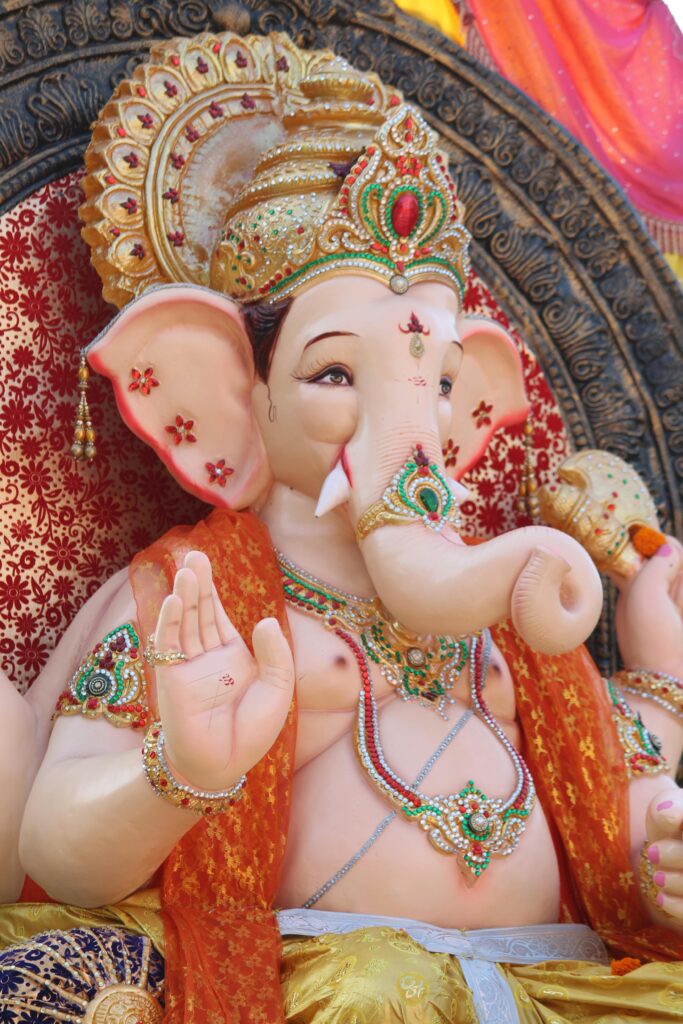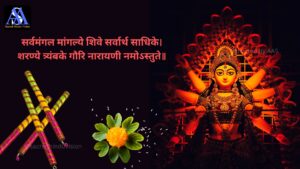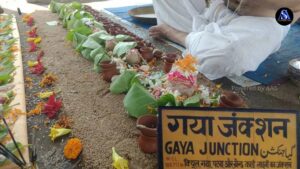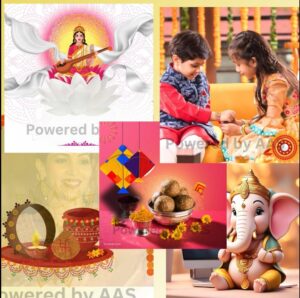Table of Contents
ToggleHello friends.
Welcome to our website again with a new blog where we embark on a journey to explore the excitement and culture behind Indian festivals. Today, we will discuss some special festivals that not only hold a unique identity in our country but also globally. Whether it’s Makar Sankranti or Basant Panchami, each festival has its own uniqueness which we will explore in detail today. So, let’s start and dive into the world of these unique and colourful celebrations.

A festival of brother and sister – Raksha Bandhan
- Raksha Bandhan in Indian culture symbolizes the love and affection between siblings. This festival is celebrated annually on the full moon day of the Shravan month, usually falling in August. On this day, sisters tie a Rakhi, a thread of protection, on their brothers’ wrists as a prayer for their brothers’ safety.
- Sisters also apply a tilak on their brothers’ foreheads and perform aarti, wishing for their long life and success. In return, brothers give gifts to their sisters, symbolizing their love and protection. These gifts traditionally relate to clothing, jewelry, or other personal items that the sister might like. On Raksha Bandhan, all family members come together to celebrate. Special dishes and sweets are prepared at home. Everyone sits together to eat these dishes, enhancing harmony and happiness within the family.
- Raksha Bandhan not only strengthens the bonds between siblings but also brings the entire family together. It encourages understanding and sensitivity in society, establishing better social harmony. Thus, Raksha Bandhan teaches us the importance of affection and protection in relationships and how they fortify and secure our lives. This day renews the love between siblings each year and strengthens their bond further.

Ganesh Chaturthi
- Ganesh Chaturthi is an important festival in Hinduism celebrated to enjoy the birth of Lord Ganesha. It occurs on the Chaturthi of the bright half of the Bhadrapada month, typically in August or September. Special rituals and worship are conducted on this day as Lord Ganesha’s birthday.
- During Ganesh Chaturthi, devotees install clay idols of Lord Ganesha in homes or public pandals. These idols showcase various forms and sizes and represent art and culture. Proper rituals and hymns dedicated to Ganesha are performed at the time of the idol installation. Throughout the ten-day festival, special aartis, offerings, and prayers are conducted.
- Devotees offer modak, durva grass, and other favored items to Ganesha. Various cultural events such as dances, music, and plays are organized during these days, enhancing the festival’s grandeur. At the festival’s conclusion on Anant Chaturdashi, Ganesha idols are immersed in a river or sea through a procession. This immersion ritual symbolizes Lord Ganesha’s return to his celestial home.
- During immersion, people chant “Ganpati Bappa Morya, agle baras tu jaldi aa,” hoping for Ganesha’s swift return the following year. Ganesh Chaturthi is not only religiously significant but also symbolizes unity and collective joy in society. This festival provides an opportunity for people to come together and celebrate, fostering positivity and hope within the community.

Makar Sankranti
- Makar Sankranti is an important festival in the Indian calendar, celebrated as the Sun god enters the sign of Capricorn. It usually falls on January 14 or 15 each year. This day is also known as Uttarayan because it symbolizes the northward movement of the Sun. On Makar Sankranti, a traditional Indian dish called khichdi is specially prepared and eaten. People also enjoy kite flying, which is an exciting activity on this day.
- Additionally, giving charity is also significant, where people donate grains, clothes, and other essential items to those in need. This day is celebrated under various names and traditions in different parts of society, such as Pongal in Tamil Nadu and Lohri in Punjab. On Makar Sankranti, people go to holy rivers for a bath and worship the deities. The festival symbolizes new beginnings and conveys the message of energy and hope from the Sun.

Basant Panchami
- Basant Panchami is a major festival occurring in the Magh month of the Hindu calendar, celebrated as the birthday festival of Goddess Saraswati. It also symbolizes the onset of the spring season.
- On this day, Saraswati Puja is conducted in schools and colleges, where both students and teachers place their books and musical instruments in front of the deity. Yellow color holds special significance as it reflects the pervasiveness of the spring season, thus people wear yellow clothes on this day.
- Special dishes like saffron rice and kheer are prepared as offerings during Basant Panchami. During the festival, blessings are also given to children to start writing and reading, known as ‘Vidyarambha Sanskar’. Worship of Goddess Saraswati is sought for prosperity in the fields of knowledge, music, arts, and culture. This day is particularly significant for artists, musicians, and students.

Karva Chauth
- Karva Chauth is a Hindu festival primarily observed by married women in North India. On this day, married women fast from sunrise to moonrise praying for the longevity and prosperity of their husbands. Women do not eat or drink anything throughout the day until they see the moon in the evening.
- After moonrise, they offer water to the moon and break their fast with water handed to them by their husbands. Women dress up specially in traditional jewelry and sarees for the occasion. During the Karva Chauth Puja, women gather to rotate the puja thali and listen to stories. During the festival, family members come together to honor the fast, and husbands express their love and dedication towards their wives.

Friends, today, our blog ends here. I hope you enjoyed this information and now have a better understanding of the stories and significance behind these festivals. If you found this blog useful, please like, share, and visit if you are new to our website. Your suggestions and comments will help us improve. We’ll meet again with a new blog, until then, goodbye and thank you.
Thank you.
जय श्री राम।।
Please Share Through Various Platforms.
Sharad Purnima – Revolutionary Rituals & its importance
या देवी सर्वभूतेषु शक्ति-रूपेण संस्थिता।नमस्तस्यै नमस्तस्यै नमस्तस्यै नमो नमः॥ i.e., “Salutations again and again to the Divine Goddess who dwells in all beings in the form of power (Shakti).” Hello friends. Welcome to our Website. This blog is going to be a sensation for everyone thinkers definitely. In this blog, we will talk about The Great Iron Man: – Sardar Vallabhbhai Patel & his thoughts and actions for Hindus & Hindu visions. In the vast
Durga Puja: Mahashaptmi Significance, Rituals, and Spiritual
या देवी सर्वभूतेषु शक्ति-रूपेण संस्थिता।नमस्तस्यै नमस्तस्यै नमस्तस्यै नमो नमः॥ i.e., “Salutations again and again to the Divine Goddess who dwells in all beings in the form of power (Shakti).” Hello friends. Welcome to our Website. As the warm colors of autumn mix with the sweet smell of shiuli flowers and the lively beats of dhak drums, Durga Puja 2025 begins on Mahashashthi, which is September 28. This five-day event is full of deep devotion, beautiful

“Navaratri: A Pivotal Tour of Inner Power and Divine Triumph”
या देवी सर्वभूतेषु शक्ति-रूपेण संस्थिता।नमस्तस्यै नमस्तस्यै नमस्तस्यै नमो नमः॥ i.e., “Salutations again and again to the Divine Goddess who dwells in all beings in the form of power (Shakti).” Hello friends. Welcome to our Website. Today we will discuss a topic i.e., Navratri: A Vibrant Nine-Day Festival of Devotion, Dance, and Divine Power. Navratri, meaning “nine nights” in Sanskrit (“nava” for nine, “ratri” for nights), is one of India’s most colorful and spiritually significant Hindu

Mahalaya Amavasya: A Sacred and Spiritual Festival – 02
Mahalaya Amavasya is a sacred Hindu observance marking the end of Pitru Paksha—a period dedicated to honoring ancestors through rituals like shraddha and tarpan. Families across India pay homage to departed souls, seeking their blessings and peace. This day not only upholds the tradition of expressing gratitude to ancestors but also heralds the onset of Devi Paksha and Durga Puja celebrations. Mahalaya Amavasya stands as a beautiful blend of remembrance, spiritual reflection, and the renewal of hope, emphasizing the eternal bond between generations and the cyclical nature of life itself.

महालय अमावस्या: एक पावन और आध्यात्मिक पर्व
ॐ पितृभ्यो नमः।श्रद्धया पितॄन् स्मरामि विश्वपितॄन् च सर्वशः।तेषां पुण्यकृतां देवानां च पितॄणां च वयं नमामः। i.e., Om salutations to the ancestors.With reverence, I remember the ancestors, the universal forefathers who are virtuous gods.To them, the holy ones and the ancestors, we offer our salutations. नमस्कार दोस्तों! स्वागत है आपका हमारे चैनल पर। महालय अमावस्या का यह शुभ अवसर हमारे बीच एक बार फिर उपस्थित हुआ है। यह दिन हिन्दू पंचांग के अनुसार पितृ पक्ष का

Hindutva: The Ultimate Political Empowerment of Culture – 02
नमस्ते सदा वत्सले मातृभूमे त्वया हिन्दुभूमे सुखं वर्धितोहम्।महामङ्गले पुण्यभूमे त्वदर्थे पतत्वेष कायो नमस्ते नमस्ते॥ i.e., O loving Motherland, I always salute you! On this Hindu land, I have grown up happily with your nurture and care. O most auspicious and sacred land, for your sake I offer this mortal body. I bow to you again and again.. Hello friends! Welcome to our Website. Today we will discuss a topic that has deeply influenced Indian politics:

Celebrating major Hindu festivals and their significance – 02
Hello friends. Welcome to our website again with a new blog where we embark on a journey to explore the excitement and culture behind Indian festivals. Today, we will discuss some special festivals that not only hold a unique identity in our country but also globally. Whether it’s Makar Sankranti or Basant Panchami, each festival has its own uniqueness which we will explore in detail today. So, let’s start and dive into the world of



